|
Introduction
[Please note: my article uses images kindly allowed for me to use which were created by other people. By including them in this article, no author of those images is either agreeing or disagreeing with my conclusions or my article's publication. The position and direction of my work here is mine alone].
One of our regular visitors wrote in with some interesting comments, which I did not entirely disagree with.
One point made was that some of our material strays away from pure microscopy and into other realms. A lot of my own writing, for example, wanders into computer graphics and other topics. I am not in disagreement. But if you look at things under a microscope, have a keen mind, you are curious and reflective, then you are likely to think about what you observe and apply those insights into other areas of thought and wish to communicate that to others. One of my pet musings which is probably something
we all do, is thinking about the very nature of existence. At sixty-three years of age, I still wonder if there is a meaning to life above and beyond the accepted physical nature. Namely, when we die are we really dead? Does something live on? Are we here as part of a purpose which eludes us.
Such questions and related dialogue of course belongs in a forum more associated with spirituality instead of on a science-centered web site. But that is only because we all tend to split our interests into different categories and engage in them in a similar fashion. This can lead to dry and tedious material being produced sometimes instead of thought-provoking and compelling content. One of the topics considered taboo in science related magazines and web sites is the question of creation by divine processes
or being/beings. God or Gods. For most of humankind's existence, strong beliefs were held in every tribe and civilised community for the existence of a supreme creator and for a more profound purpose to our lives. As scientific practices reveal ever more knowledge about our reality, these beliefs and the people who believe, have frequently been considered foolish. The idea of heaven, hell, souls, and God has been unfairly shunted into the realm of fantasy and into a pigeon hole considered to be created by the failure
in groups of people unable to accept the idea of their own mortality.
Science and religion is often considered to be mutually exclusive. I am a person who enjoys both what science illuminates and my own private thoughts about the meaning of life, my life, all life, and whether or not there is something more to it all other than the contemporary trend of preaching the no-God hypothesis by many learned people. I do not wish to be labeled a creationist but by the same token, I do not wish to be labeled as anything. We all do that, I guess, divide our thoughts and attention,
simplify, so we can form opinion and judgment more readily, especially where we explore complex matters. This may in itself be a weakness in ascertaining truth from knowledge. Science is not a quest for truth, it is a method for acquiring knowledge. Obtaining all of the knowledge possible does not guarantee you will find answers to anything, just knowledge.
I thought then to put my head into the lion's mouth and explore any connections between what we learn through microscopy and other sciences, and the way this knowledge may weaken or strengthen the idea we may be here not just as a result of blind mechanics but instead for a profound purpose which eludes our limited perceptions. Maybe, for most people there is likely no connection. To me the connections are there along with many questions which science has not provided satisfactory answers
for and possibly is likely never to be able to do so. Like all tools for learning, science too has weaknesses and flaws, despite its extraordinary success in teasing out knowledge from ignorance.
Let's start by examining some of the things explored under a microscope and see where it leads.
Profound Diversity and Complex Patterns
Anyone who spends time looking at organic and non-organic structures through a microscope is actually exploring a compound unit of the Universe by trying to obtain more visual detail of its form and processes. We quickly learn that everything observed is a combination of more discrete parts, brought together to form a three dimensional structure. The microscope reveals complexity and detail which evades the naked eye. Most of us would agree, I believe, that all the parts of the thing observed seem
to serve logical roles in protecting, sustaining, or preserving whatever it is. This is most true of living forms. Nature doesn't appear to waste its materials on unneccessary components, nor does any of
its various designs make anything which doesn't fit into the larger 'whole' in a way where it either competes against or works with other components of life for self-advantage. Flowers live with 'un-sensed'
cooperative relationships with their various pollinators. Most forms of life have equally adjusted and effective predators to cull and control their number.Many living things have symbiotic relationships with other living things.
Something else we may notice is the prevalence of similar geometries and patterns in often quite different living and non-living entities.
In almost verything I look at, I notice regularly formed patterns. The way in which these complex structures are made suggest (to me) an iterative process underlies and drives such formations. I am a computer programmer and coding often makes use of similar iteration. The analogy lends me to wonder, especially when looking at living forms, if a self-modifying computer program is really at work in the nature of all things.
Some would argue that such complex and iterative patterns (see below) are entirely the result of simple inherent chemical and atomic properties. Of course, I already understand that complex outcomes can emerge from just a few simple variables interacting. Look at a single stream of water falling into a pond and observe the patterns forming on the surface to quickly acknowledge complexity emerging from simplicity. Take a look at the examples below to see what I mean.
|
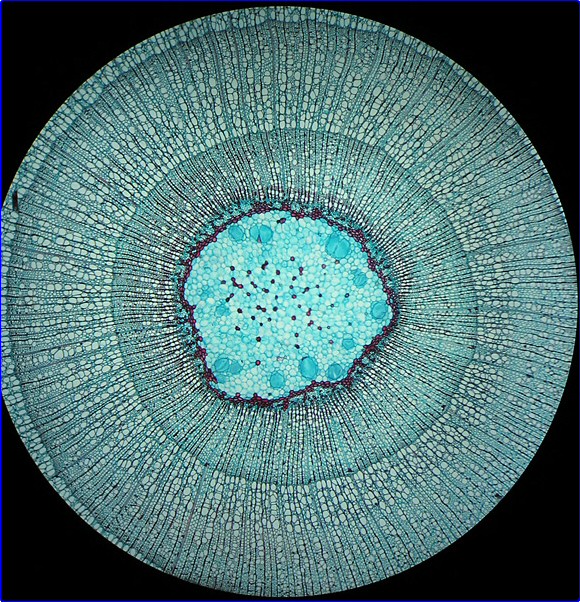
Top: Woody stem cross-section at 3 years old, 4x objective, a Brunel slide. Photograph Ian Walker
|
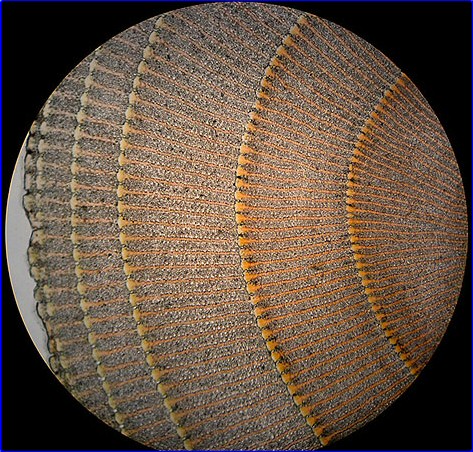 |
|
Right: Section of Cideris Spine. Photograph Ian Walker
|
Such code may be perceived as the legacy of genetic code and the result of it's interactions within the organic material it manages to manufacture and develop a living structure. But...similarly sophisticated patterns also exists in non-organic objects.. It is said that no two snow flakes ever look the same.
| |

|
Snowflake under an optical microscope, licensed under the Creative Commons Attribution-Share Alike 2.0 Generic license. Original owner.
|
A pattern which is formed from taking a smaller part of the said pattern and repeating it over and over again, with slight variation, is a common mechanism in most things observed. To produce this effect, I consider that a self-organising characteristic is imbued upon all things I observe. Since everything in existence is constituted by an arrangement of atoms, I make the assumption that the emergence of patterning and iterative self-organisation is inherited
from those atoms, or from a characteristic the atoms themselves inherit from an even smaller element of themselves (quarks?). If instead, this fundamental characteristic was, say 'self-disorganising', we would all be non-living in a non-cohesive reality, where no structures of any kind could be present to self-sustain for any length of time.
Since all material in the universe is considered to be from its origin, The Big Bang, I consider this trait is likely to have been present from the very start of the universe, or it emerged shortly afterwards. The first sub-microscopic speck of energy/matter which expanded to form our reality already contained an 'intent' or set of properties to self-cohere, and self-organise. These traits were subsequently preserved in all the fragments of material and energy as the initial micro-dot of reality expanded,
forcing the resulting fragments further apart.
Patterns of Life
When exploring creatures which are very small, no matter how tiny they are, their complex structures contain sensory processes, movement processes, reproduction systems, all organised in coherent and self-maintaining bodies. You look at a fine hair on your own body and marvel it can detect and convey to you the merest hint of movement in the surrounding air. You examine the hair closely and marvel at its fine structure, its delicate width and fine tip. Then you look at something like a silk moth antenna in an
optical microscope and see this...
|
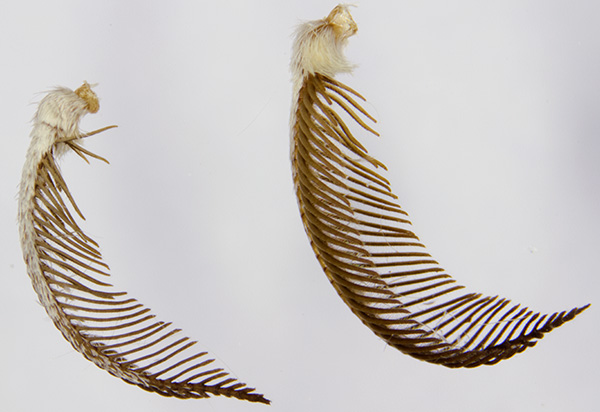
|
Original author's caption: Antenna from (suspected) male and known female B. mori are shown right (stereo 10X optical mag.). The males are described as having denser sensory hairs but the difference is not clear cut in the suspected males and known females.
Antenna 5 mm high, width at max. ca. 1.2 mm.
These antenna are vitally important to this creature in locating mates through the detection of a molecule called bombykol (a pheromone).
Photograph by David Walker
|
A study and a book from the study of Insect noses ('noses' is a metaphor here) written by Karl-Ernst Kaissling states the following -
|
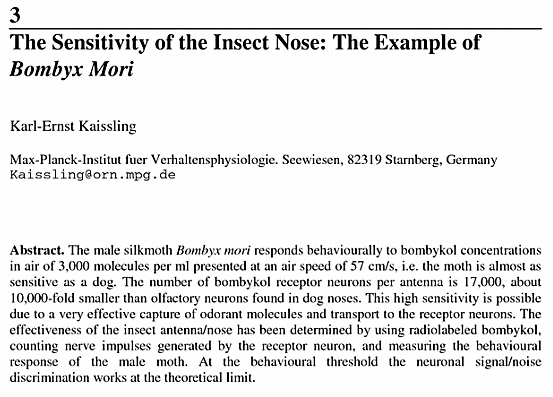
|
|
Note the remark that the moth's 'smelling' capability is almost as sensitive as a dog. The female releases the pheromone, and a male moth somewhere in the vicinity has to detect it, hone in on it, and mate with it. If that didn't happen often, effectively, over long periods of time , months die out.
This might be considered by you the reader as pretty much unexciting and nothing miraculous. But a similar process (not necessary 'smell') exists in all complex living organisms to preserve genetic packages and mix them between male and female members of a species, only when another set of variables are just right for healthy recreation of a new member of the species.
|
It would appear that even with 13.5 billion years for the universe to (blindly?) explore what it can make, it has been unable in this neck of the woods to create a living form which does not age and die. But it has found a solution in the idea of recreation through reproductive systems and genetic inheritance. It would also appear that once a novel pattern or a system proves effective in sustaining living organisms the process is exploited across many other species.
A good engineering methodology and a solution to a problem is 'sprinkled' around other living forms once that solution has manifested just once.
But back to our moth antenna.
|
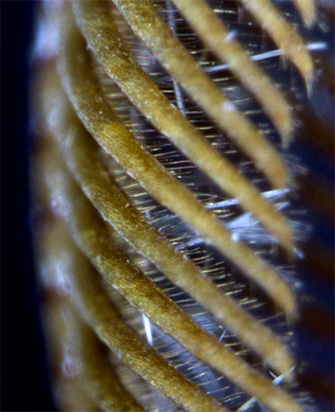
Original author's caption: Image above: Close up of an antenna showing the finer hairs leading from each side 'rib'. Each 'rib' ca. 68 µm wide at max. (Stereo 30X optical mag.). by David Walker
Image Right: Detail of an antennae to show the surface structure and sensory hairs. 'Magnification X800 when printed 10cm wide.'Implies main 'rib' is 55 µm wide and each hair is ca. 2.6 µm wide.
Image courtesy and copyright of Oliver Meckes of Eye of Science. Please contact them for image use. Explicit permission is required.
|
|
(Left) - Here is the antenna again magnified just 30 times. Denote the tiny hairs extruding from each rib. Now look at one of the hairs on the back of your rib with one eye closed and hold your hand up so that light passes over it to your eye. Who has the finer hair would you say, you or the moth?
But let's not stop there. A closer look reveals not only the finer detail of the hairs but something difficult to see with an optical microscope:
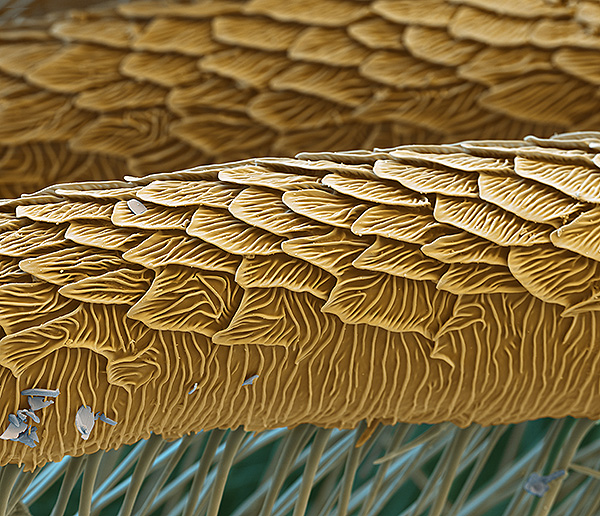
Look at the surface pattern of the antenna rib. Scales? Um... I thought snakes had scales. It transpires that a lot of different creatures share design solutions but applied to different processes in their structures. Sharks, for example, have a body covered with dermal denticles, which are small plates covered with enamel, similar to that found on our teeth. Fish have scales which look similar to the scaly surface of the moth antenna (to my eye).
|
We see processes visually with an optical microscope but we also observe patterns with the naked eye and many man-made sensing devices. Life uses similar components in similar patterns like lego bricks to build a multitude of different living organisms.
How many different life patterns (designs) to you think there are for life on Earth? The answer is no-one knows! Current estimates are around 8.5 million. Experts estimate that the various forms of life on the planet included 7.8 million species of animal, 298,000 species of plant and 611,000 species of mushrooms, mould and other fungi along with 36,400 species of protozoa, single-celled organisms, and 27,500 species of algae or chromists. The researchers did not venture to put an estimate on the number
of bacteria.
The stunning additional piece of information I can now reveal to you is that this enormous diversity and number may only constitute 10% of all the different living entities on earth. We haven't probed deep or far enough yet to include bacteria, many insects, micro-organisms, the deep oceans, nor can we explore much in the way of micro species which may have become extinct or evolved into something different to their original form, and each living entity itself probably have internal
flora never researched. And then there is the problem of classifying one type of life from another. Sometimes, one tiny aspect classifies it as a different species. Nature appears always to be conservative with its resources, why produce so many different types of life?
|






